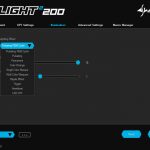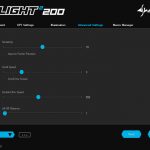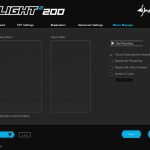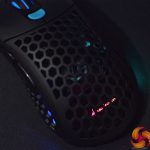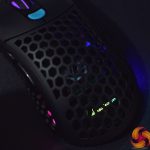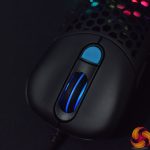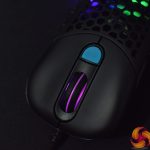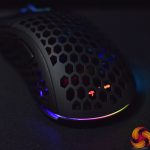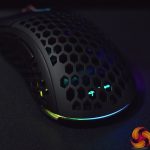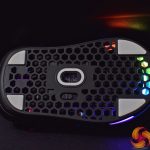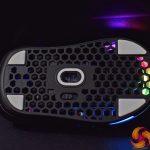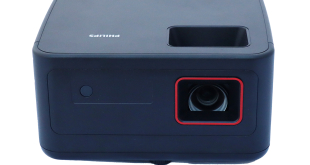To test the Light2 200, I used it as my daily driver for just under a week. We break down testing into four main sections: software, lighting, build quality and comfort, and performance.
Software
Starting with the software, this is a simple application from Sharkoon but I think it ticks most of the boxes. It's divided into 5 separate tabs:
- Button Assignment lets you re-map the 8 different button/wheel functions
- DPI Settings enables you configure up to 7 DPI stages, adjustable in increments of 50
- Illumination lets you choose from a range of lighting presets, adjust brightness and speed
- Advanced Settings offers control over mouse sensitivity, scroll speed, double click speed and lift-off distance
- Macro Manager is used to record and edit macros
Honestly, as far as software suites go, I've no major complaints here. The UI doesn't look as polished as Razer Synapse or Corsair iCUE, but there's control over a lot of different settings in the app – compared to something like the Glorious Model O software, this is definitely more in-depth.
Best of all, there's support for up to 5 on-board profiles thanks to 64KB mouse memory, so you can configure the settings to your liking and simply uninstall the software if you wish to.
Lighting
There's three RGB zones on the Light2 200 – the scroll wheel, the Sharkoon logo at the bottom of the PCB (under the shell), and then a small strip and the bottom of the mouse. I wouldn't say the mouse has blown me away with how good the RGB looks, primary because the LEDs aren't the brightest, but it's certainly passable and there's a number of effects to choose from in software.
Build quality and comfort
Moving onto overall build quality, this is an interesting area given the trend of ultra-lightweight mice – certainly, filling a mouse shell full with holes isn't going to make it any stronger. That said, I can't really complain of any major issues with the Light2 200's build quality, but there's just a couple points to note.
First of all, I did notice a small amount of flex to the top of the shell when pressure was applied. However, I didn't notice any flex during normal use, it was only when I deliberately pressed down hard on the mouse that this would happen, so it's not a factor for normal everyday use.
In a similar fashion, you can actuate the buttons on the left-side of the mouse by squeezing the sides of the mouse shell. Again, though, when I was gripping the mouse normally, this simply did not occur – to get the buttons to actuate you have to use an unreasonable amount of force that it's simply not going to happen during normal usage.
Impressively, there is also no audible rattle when using the mouse, even when I picked it up and gave it a good shake I couldn't hear any rattle from either the sensor lens or the scroll wheel.
In terms of comfort now, there's a good chance you have used a Zowie EC mouse already, and if you haven't something like the Razer Mamba or SteelSeries Rival is going to give you a good idea whether or not you would like the shape. Simply put, this mouse can work for pretty much any grip type, depending on your hand size. I myself have 18.5x9cm and found it comfortable to claw or palm grip. If your hands are on the bigger side, then the Light2 200 may be slightly small, but for a lot of people this is going to be a very safe ergonomic shape.
The only other thing I noticed in terms of comfort is related to the removable top shell of the mouse. On just a few occasions I noticed this removable panel moving ever so slightly under my palm, just towards the bottom of the mouse where it is held in place with two magnets. This really didn't happen much during my testing, but every now and again I felt the shell move slightly. I wouldn't say it's a big deal, but if Sharkoon could eliminate the slight movement entirely in a future revision, that would only improve things.
Performance
Now it's time to talk about how the Light2 200 performs day to day. I'll start by touching on the primary buttons, and I have to say these are some of the best I have used in a gaming mouse. The actuation is light and crisp, yet still very satisfying and I was able to repeatedly mash them at high speed. There is only minimal pre- and post-travel from the shell, too, maybe slightly more than something like the Endgame Gear XM1, but overall these are excellent primary buttons.
The side buttons are also very good, with essentially no pre-travel and a light and fast actuation. The buttons are also nice and low-profile so they didn't interfere with my grip at all. I did notice just a small amount of wobble from these buttons when resting my thumb on top of them, but nothing significant whatsoever.
As for the scroll wheel, this again has a tight and satisfying click – it's on the heavier side to click in so rapid presses may be tricky, but I had no issues using it for frags in PUBG. I wasn't as keen on the scrolling experience though, as the steps aren't that well defined – it's easy to flick the wheel and get some serious movement from it, but you don't get as tight or well defined steps when scrolling slowly which I did miss here.
In terms of sensor performance, as the Light2 200 uses the PixArt PMW 3389 – a top of the line optical sensor – I wasn't expecting any issues and that's exactly how things played out. Simply put, whether I was editing photos at 400DPI or gaming at 1200DPI, I had no issues with overall tracking and couldn't detect any unwanted acceleration or jitter. As a final point, I couldn't get the sensor to spin out either, no matter what I tried, so all around top marks here.
The Light2 200 also offers software control over the mouse's lift-off distance (LOD), with three settings available. The first setting, ‘1' (which I presume means ‘1mm'), would not track with the mouse set 1 DVD high from the ground. Raising this to setting ‘2' would track on from 1 DVD high, but stopped tracking at 2 DVDs. The final setting, ‘3', would track from 1 and 2 DVDs high, but stopped tracking at 3 DVDs. Overall behaviour is pretty much as expected then.
Finally, we must also mentioned the cable. It's 1.8m long and braided, supposedly ‘ultra-flexible', and in my experience it is overall a passable cable but ‘ultra-flexible' is definitely pushing it too far. Definitely compared to the likes of the Cooler Master MM711 or Xtrfy M4, the Light2 200's cable does feel noticeably thicker and slightly less flexible than those two competitors. I found it best when using the cable in a bungee to reduce its overall movement.
To be clear, I wouldn't say it is a bad cable at all, but relatively speaking it is the main area to be improved for Sharkoon.
 KitGuru KitGuru.net – Tech News | Hardware News | Hardware Reviews | IOS | Mobile | Gaming | Graphics Cards
KitGuru KitGuru.net – Tech News | Hardware News | Hardware Reviews | IOS | Mobile | Gaming | Graphics Cards




